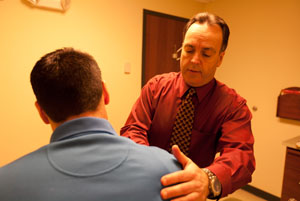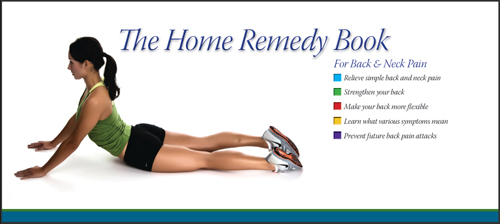- Locations
- Find a Physician
- By Physician
- By Department
- The Center for Spine Health
- Hand & Wrist Center
- Shoulder & Elbow Center
- Foot & Ankle Center
- Joint Replacement Center
- The Sports Medicine Center
- Pediatric Orthopedic Center
- Trauma & Fracture Center
- Osteoporosis and Bone Health
- Oncology Center
- Cartilage Repair Center
- Concussion Rehab Center
- OrthoDirect
- Careers
- Patient Portal
- Intranet
Nonsurgical pain relief
Return to activity | Diagnostics | Pain relief | Time | Limiting rest | Physical therapy | Exercise | Injection therapy | Types of medication | Massage | Biofeedback | Acupuncture
For damaged
structures to heal, good blood supply is essential for repair
and to remove waste products. The bones, ligaments and muscles
in the back have a good blood supply, so the back can heal reasonably
well. The problem is that they usually heal with a special type
of tissue called scar tissue, which is strong but not as flexible
as normal muscles, ligaments, etc. However, discs have a poor
blood supply and this often results in slower healing. Discs,
therefore may be more easily damaged if care is not taken to
prevent this. The most common type of injury to the back is to
the soft tissue – the muscles, tendons and ligaments. Most
of these soft tissue injuries heal well, and this is why most
people with back injuries recover.
However, discs have a poor
blood supply and this often results in slower healing. Discs,
therefore may be more easily damaged if care is not taken to
prevent this. The most common type of injury to the back is to
the soft tissue – the muscles, tendons and ligaments. Most
of these soft tissue injuries heal well, and this is why most
people with back injuries recover.
Back pain is often an unseen injury to others. As such, it is sometimes difficult to understand the problems that a person with back injury has to live with daily. To help yourself, it is important to keep as mobile as possible and learn how to move your body to prevent strain on your back.
Return to activity
The primary goal of treatment is to get you back to your everyday activities.
During your initial visit, the physician will assess your medical history and collect more specific information during the exam. In order to better understand your back or neck problem, the physician may gently move your joints and limbs. It is important to answer all the physician’s questions honestly, because your answers help determine a correct diagnosis.
[Top]
Types of diagnostics you may encounter:
- X-rays show bones and the space between bones. Although X-rays are of limited value to muscle-related back pain cases, your physician may conduct X-rays to detect possible fractured vertebrae or narrowing of disc space.
- MRIs (Magnetic Resonance Imaging) and CT scans provide images of soft tissues and nerves in the spine, including discs and joints. This is valuable information to your physician in determining the cause of your pain. These tests provide a medical photograph of your body and are painless.
- Pain-relieving injections can relieve back pain and provide important information about your problem.
- Myelograms can reveal the amount of damage in the spine. They are used to determine if surgery is necessary. If it is, myelograms provide a surgeon with key information to ensure the success of surgery.
Pain relief
Doctors who focus mainly on pain symptoms often recommend the
exact opposite course of action that is optimal for recovery
from a back problem. For example, years ago, doctors treated
back pain with bed rest and heavy drugs in order to mask the
patient’s discomfort. Patients became sedentary and increasingly
dependent on drugs. It was later discovered that this treatment
was actually damaging to the back, because it weakened muscles
and caused more pain.
Pain is a signal from the body to the brain that something is wrong. Either a certain motion placed too much strain on the back, or the back is too weak or inflexible. Your specialist will help determine the origin of your pain and the best treatment for it. Click here for more information.
[Top]
Give it some time
Time is your most valuable asset. In cases where pain is focused in the low back or when there are red flag symptoms, take the time to help yourself. Check out the home remedy section of this Web site for ways to treat your pain.
[Top]
Limiting rest
Studies have reported that rest and inactivity should be limited to two days at most. After that time, patients should be encouraged to start moving and exercising to strengthen the back muscles and increase flexibility. And part of the rehabilitative process can require a commitment on the part of the patient to work closely with the therapist during those first few weeks to ensure a successful long-term recovery.
While drugs and manipulation may relieve initial pain, neither of these alters the musculature of the back, which is essential for long-term recovery. Only exercise can strengthen the back muscles and make them more flexible and resistant to future strain.
[Top]
Physical therapy
Physical therapy increases flexibility and strengthens muscles that support the spine. Greater strength and flexibility will help prevent future back strain. A therapist may use ultrasound, electrical stimulation, heat or ice, mobilization and exercises to reduce pain and the likelihood of future injury. Click here for more information.
[Top]
Exercise
Years ago, the prescription for pain was bed rest. However, we know today that more than a few days of bed rest after an injury can be counterproductive to rehabilitation.
Exercise and movement actually help tissues in the back become stronger, more supportive of the back and resistant to additional injury. Specific exercises can be used to target particular types of back pain. Engaging in activity acts as a lubricant to the back muscles and joints, and it is as necessary to recovery as oil is to the hinge in a squeaky door.
It is important to work with a therapist to make sure exercises are done properly. Never do any exercise that causes pain to your back. Click here to learn about specific back pain exercises.
[Top]
Injection therapy
For years, spine physicians have used cortisone injections, epidural steroid injections, trigger point injections and nerve blocks to relieve pain in the spine. They are often provided in a series of three or four injections spanned over a couple weeks.
These injections are intended as a means to an end. The goal is to provide enough pain relief to bridge the patient from being inactive to being able to attend physical therapy, where they can better treat their back problems with special exercises.
Common types of injections for back pain relief include:
- Epidural
- Selective nerve root block (SNRB)
- Facet joint block
- Sacroiliac joint
- Vertebroplasty
For more information on the common types of injections for back and pain relief click here.
[Top]
 Medication
Medication
Medications can lessen swelling and reduce pain in the back and neck. The type of medication your physician recommends depends on your symptoms and your level of pain.
At home, pain can be relieved with Non-Steroidal Anti-Inflammatory Drugs (NSAID), such as ibuprofen products like Motrin or Advil. Aspirin may also be recommended to ease pain.
[Top]
Massage
Not only is it relaxing, but massage has notable health benefits that are an important part of back rehabilitation. Massages release toxins in muscles, increasing circulation, releasing endorphins, reducing inflammation, alleviating muscle cramps, breaking down scar tissue and calming the nervous system.
Aside from the physical health benefits, massage has a psychological impact by teaching the patient to feel relaxed. For the chronic back pain sufferer, even the simple luxury of drifting off to sleep may not be a reality. Massage can provide that feeling of calm.
[Top]
Biofeedback
For thousands of years, Eastern medicine has emphasized the importance of the mind in controlling physical health. In the West, these ideas were touted as mystical and scientifically unfounded. Recently, however, as more scientific connections are being made between mind-body healing, Western science is starting to appreciate and incorporate this type of therapy into pain rehabilitation.
Due to its objective means in tracking progress, biofeedback is one of the more popular mind-body therapies in pain rehabilitation. During biofeedback sessions, electrodes are attached to the body to monitor body temperature, heart rate, muscle tension, skin resistance and perspiration.
Through biofeedback, the patient is taught to recognize how stress and relaxation chemically alters the body's functions. The patient can learn to lower heart rate and muscle tension. The biofeedback equipment records statistics and gauges progress as the patient learns to control the body, thus controlling pain.
After recognizing the body’s signals during biofeedback sessions, the patient is able to recognize them in daily life and arrest the onset of muscle spasms or high blood pressure. This can reduce pain and even eliminate it.
[Top]
Acupuncture
Traditional acupuncture is based on the ancient Chinese theory that there are energy pathways that run throughout the body. These pathways, called meridians, carry the body's vital energy, or chi (pronounced "chee"). The principle behind acupuncture is that disease and pain are a result of an imbalance in the body's energy flow (chi). Through the insertion of thin needles at specific points along meridians, the flow of energy is controlled and rebalanced in the body.
Acupuncture dates back to the first century B.C. in China, during the era of the Han dynasty (206 B.C. - 220 A.D.). Because Western physicians in the United States have difficulty understanding the correlation between acupuncture philosophies and traditional physiology, acupuncture has not been readily accepted in the United States.
Modern scientists have attempted to explain how acupuncture can relieve pain. Some observe that the traditional Chinese "meridians" overlap with pathways of the central nervous system. By using needles, an acupuncturist can stimulate the nervous system to release endorphins (morphine-like chemicals) in the muscles, spinal cord and brain. These chemicals either relieve pain symptoms or trigger other chain reactions that relieve them.
Acupuncture is nonsurgical, does not involve drugs, and has no extremely negative side effects or permanent complications. It may be worth exploring as a nonsurgical option, particularly if you have exhausted the traditional remedies of Western medicine.
[Top]








